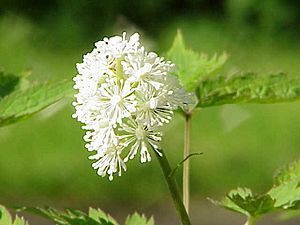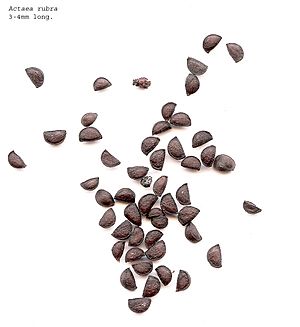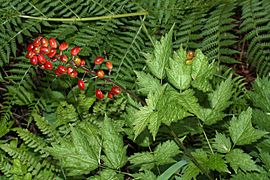Red baneberry or chinaberry facts for kids
Quick facts for kids Red baneberry or chinaberry |
|
|---|---|
 |
|
| Scientific classification | |
| Genus: |
Actaea (plant)
|
| Species: |
rubra
|
| Subspecies | |
|
|
Actaea rubra, also known as red baneberry or chinaberry, is a wild plant found in North America. It's a flowering plant that grows from the ground each year. Be careful, because this plant is poisonous! It belongs to the buttercup family, called Ranunculaceae.
Contents
What Does It Look Like?
These plants grow in open woodlands. They can reach a height of about 40 to 80 centimeters (1.3 to 2.6 feet).
Its leaves have rough edges and deep cuts. The veins on the underside of the leaves are often hairy. Each plant stem usually has three leaves that branch out near the top. Sometimes, it has three larger leaves and one tall stalk that holds flowers.
The plant produces clusters of white flowers. Each flower has 3 to 5 petal-like parts called sepals. These sepals stay on the plant even after the flower blooms. The actual petals are small and fall off once the flower is done. Flowers also have many white stamens.
Berries
After the flowers bloom, small green berries start to grow. These berries are shaped like tiny eggs and hold several seeds inside.
In the middle or late summer, the berries turn bright red. Some rare types have white berries instead. All the berries have a small black dot on them.
Where Does It Grow?
Red baneberry plants like shady places. They grow best in moist or wet soil. You can find them in open forests or on dry slopes. In Alaska, they grow from the Kenai Peninsula up to the Yukon River. They are also found across much of Canada and the northern United States.
How Does It Grow?
These plants grow slowly. It takes a few years for them to get big enough to produce flowers. There are two main types, or subspecies. One is called ssp. arguta and grows in the west. The other is ssp. rubra and grows in the north. These types are quite similar and often blend into each other.
Animals that graze, like deer, usually do not eat the leaves. This is because the plant is poisonous. Birds, however, can eat the berries without harm. Birds help spread the plant's seeds to new places.
How People Have Used It
People sometimes grow red baneberry in their gardens. They like its bright berries and how it grows in neat clumps.
Native Americans traditionally used this plant in different ways. They used the juice from the berries to make poison for arrows. They also used the plant's root as a traditional medicine for certain health issues.
Is It Dangerous?
Yes, all parts of the red baneberry plant are poisonous. However, it's not common for people to get poisoned by accident. This is because the berries taste very bitter.
The berries are the most toxic part. Eating even a few berries can make a healthy adult sick. If someone eats the berries, they might feel sick to their stomach, dizzy, or have a fast heartbeat. The toxins can also affect the heart. For a child, eating as few as two berries could be very dangerous.
The plant contains chemicals that can irritate the body. These are found mostly in the roots and berries.
There have been no reports of serious poisoning or deaths from red baneberry in North America. However, its European relative, Actaea spicata, has caused deaths in children.
Red baneberry looks a bit like another plant called mountain sweetroot (Osmorhiza berteroi). But you can tell them apart because red baneberry does not have a strong "spicy celery" smell like mountain sweetroot does.
Images for kids




